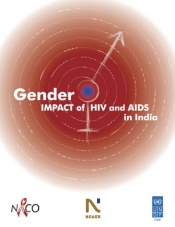Gender Impact of HIV and AIDS in India
Ramamani Sundar
Basanta K. Pradhan
May 2012
This study analysed the impact of HIV and AIDS on women and girls by examining a cross section of issues such as household income, savings, consumption as well as education, health and levels of stigma and discrimination. The study, conducted in 2004-05 by the NCAER, with the support of UNDP and NACO, was based on a primary survey of 2,068 HIV and 6,224 non-HIV households spread over rural and urban areas of six states with high prevalence of HIV in India. The findings indicate that female members of HIV households face increased burden of workload at home and are also required to take up employment to supplement lost earnings. The burden of caring for people living with HIV and AIDS (PLWHA) is proportionately higher in the case of women, whether or not they themselves are HIV-positive. Compared to men, nearly double the number of women are left untreated. Though all PLWHA face discrimination, for women, the degree was higher and often from within the family.
Human Development and Data Innovation
States, Sectors, Surveys, and Impact Evaluation







